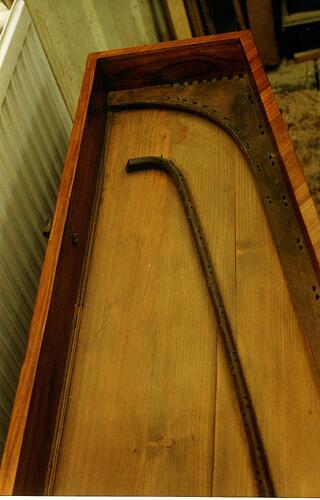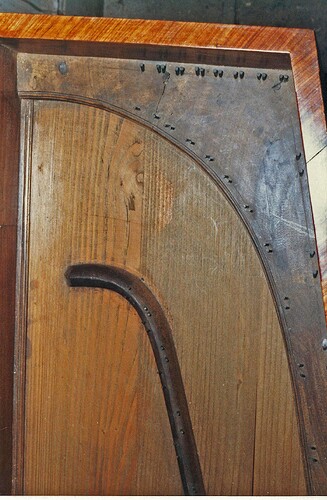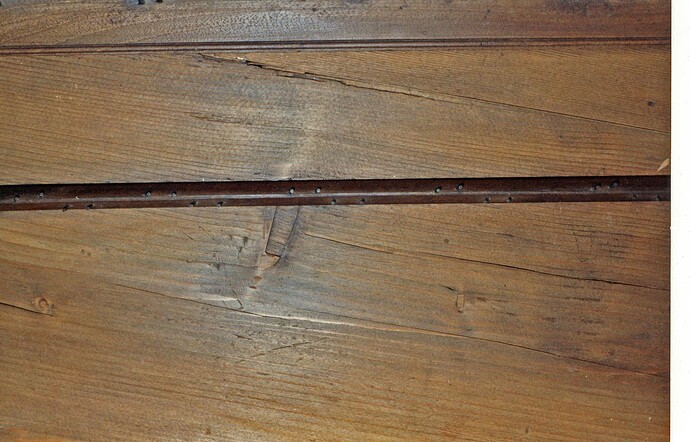Dear friends, l am looking for an image from Doderers/van der Meer’s book on portuguese keyboard building. I have the book at home but l am currently not there. Does anyone have a copy of it and if so could they scan for me the page of the shapes and mouldings of the Antunes 1785 harpsichord. Your help is very much appreciated.
Best. PJB
Sorry, l meant shapes of the bridges and mouldings……
Hi Pieter-Jan,
here are some pictures of the bridge.
As for the case and soundboard mouldings, I have none but I don’t think Antunes 1785 has any real “moulding”: I have the drawing made by Chris Nobbs and where you’d expect a “moulding” there are only rectangular-cross-section battens. The bridhe itself hasn’t any moulding as the ones one can see in Italian harpsichords.
Best.
Dom
I am struck by the complete rubbish soundboard wood. Interesting!
Andrew, I am astonished how a so good-sounding harpsichord can be made by so bad wood - not only soundboard - and with so less-than-ideal workmanship.
The original is in the USA now.
Thanks Dom, this is very informative. This is the bridge of the 1785 Antunes?
As for the soundboard wood: they didn’t use quarter sawn sounboard wood, as did Italian builders sometimes(?) didn’t use quarter sawn cyprus for their soundboards.
PJ
Yes, this is the bridge of the 1785 Antunes.
As for the soundboard wood, it does seem to me quartersawn spruce, but it is its quality which is puzzling: knots, waving grain, large grain and so on. Other parts of the instruments are of similar wood quality.
Just goes to show that we moderns are overly obsessed with perfect wood.
Some very great violin makers used knotty wood with wavy grain also. [I’ll dig up some examples.]
Le 25/07/2023 14:45, Andrew Bernard via The Jackrail écrit :
Just goes to show that we moderns are overly obsessed with perfect wood.
Some very great violin makers used knotty wood with wavy grain also.
What are the reasons for preferring close-grained wood for a harpsichord
soundboard? What are the effects of the grain on the sound?
Good question. One is cross-grain stiffness, a quantitatively (and subjectively) measurable quantity. Higher stiffness leads to higher transverse velocity of sound in the timber and this gives perceptibly better sound. Immediately people will say but Italians used slab sawn cypress. Yes, but cypress has good acoustic transmission anyway, apart from being dead common in Italy and cheap. Knots interrupt the transmission of vibrations in the wood so you generally don’t want them. Quartersawn spruce, as with any quartersawn timber, is very stable and so does not warp. That’s unrelated to sound but it’s mutilfactorial. It appears from my understanding that the closer the grain the stiffer and the higher the velocity of sound waves, and so that’s why people choose the more expensive cuts of spruce.
There’s a large literature on this re violin making of course. I’ll see if I can dig up some more facts. In master Cremona violins you can often see the belly wood has the wider grain at the edge and the finer in the middle. That’s very interesting. Sometimes you see the wider grain grading to wider just on the bass side. I am talking about makers like Guarnerius, so not just ordinary bods.
This why carbon fibre is really good for violins, because you can make it very stiff indeed.
Of course, this begs the question why does a higher velocity of sound in soundboard material make it sound better? I do not have a clear answer on that at the moment except to say that you can hear it empirically. May have something to do with less attenuation of high frequencies and therefore upper harmonics of notes.
Which of course begs the question of why does the ear like sounds rich in harmonics…
Le 27/07/2023 07:36, Andrew Bernard via The Jackrail écrit :
Of course, this begs the question why does a higher velocity of sound in soundboard material make it sound better? I do not have a clear answer on that at the moment except to say that you can hear it empirically. May have something to do with less attenuation of high frequencies and therefore upper harmonics of notes.
It also begs a couple of other questions: Is close-grained wood that is
“good” for a violin also good for a harpsichord? Or a double bass? And
should the grain count be the same across the whole range of a harpsichord?
I raised this same question some ten years ago, and came across the
following site that seems to say the sound is different, but not
necessarily better:
“A wide grain top will tend to produce stronger bass response: That’s
because there are fewer stiff grain lines so the top is more flexible.
From the flexibility comes a lower natural resonant frequency and more
easily produced bass notes.
A narrow grain top will have comparatively stronger treble and more
subtle bass.”
http://www.frets.com/FretsPages/Musician/Guitar/ToneWoods/tonewoods1.html
Bill Jones also wrote the following at the time:
"In so far as tone production goes, there is no need to have a uniform
density of grain throughout the width of the soundboard FOR A
HARPSICHORD. Perhaps some might object to the visual appearance of
non-uniform grain count, but I was more concerned with produced sound.
Many years ago, I bought a 100-year-old Sitka spruce ship’s mast and had
it quartersawn. After a few years of drying on sticks, I ordered the
planks into groups whose cuts were closest to being radial - truly
quartersawn.
The precious few planks which were absolutely radial (sawn directly
toward the center of the tree’s growth) naturally had the largest “grain
count”; i.e., greatest number of growth rings per inch. These were
fewest in number and the widest. I reserved these for the treble sides
of the soundboards because they resonate at the higher frequencies. I
chose boards with progressively lower grain count toward the bass side
of the soundboard so as to be more productive of the lower frequencies."
I recently have been listening to a lot of recordings of the Antunes 1758 an 1785 Instruments. In all the copies l heard many more high partials in the sound than l heard in both originals. I am quite sure the modern builders used quarter sawn spruce rather than slab wood spruce. According to Geert Karman, who restored the 1789 Antunes, and maintains the other Portuguese instruments in the Lisbon instrument museum, the slab sawn spruce is essential of the style of the Portugese. As can be seen in the foto’s sent by Dom the bass part of the soundboard of the 1785 Antunes is definately slab sawn. The rest looks more or less quarter sawn but not half as fine graned as modern builders tend to look for. I imagine the barring of the soundboard is more important for the stability than the soundboard wood itself. Maybe one of the builders of the forum can shed more light on this. Anyway, the copies l heard are all far less satisfying than the originals.
PJ
Let’s move the stiffness of grain to another topic. Although this is intertwingled with the wood in the Antunes.
Hi Dom,
Do you have perhaps more pictures of the Antunes soundboard. I am quite interested how it looks in the discant….
Best
PJ
Hi Pieter-Jan,
I haven’t pictures of the upper face but I do have have soundboard pictures of the lower face, with an interesting barring, probably you’ll be able to grasp the woodgrain.
I’ll send you all the pictures I have.
Dom
As this could be of interest to other people as well, I put here a link to my pCloud folder.
The pictures and the drawing are somewhat free, so I can put them here. This is thanks to the generosity of Chris Nobbs. When I asked for them, Chris told me they were free but please do a donation to a non-profitable organization (he suggested Medecins sans frontieres). So I guess the same applies to all.
I’ll take down the link in a few days.
The link: https://u.pcloud.link/publink/show?code=kZjF3AVZq1Fjggf457frE7folluibBl07L57
Thank you Dom. Did you reach Nobbs about the drawing some time ago?
PJ
Yes, in January 2022.



